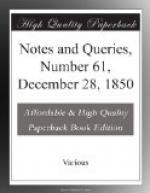The Oldenburgh Horn (Vol. ii., p. 417.) is preserved amongst the antiquities in the Gallery of the King of Denmark at Copenhagen. It is of silver gilt, and ornamented in paste with enamel. It is considered by the Danish antiquaries to be of the time of Christian I., in the latter half of the fifteenth century. There are engraved on it coats of arms and inscriptions, which show that it was made for King Christian I., in honour of the three kings, or wise men, on whose festival he used it, at Cologne.
W.C. TREVELYAN.
Wallington, Dec. 19. 1850.
[We avail ourselves of the opportunity afforded by Sir Walter Trevelyan’s communication to add from Vulpius (Handwoerterbuch der Mythologie) the following additional references to representations and descriptions of this celebrated horn—which is there said (p. 184.) to have been found in 1639:—Schneider, Saxon. Vetust. p. 314.; Winkelmann’s Oldenburgische Chronik. s. 59.; S. Meyer, Vom Oldenburgischen Wunderhorne, Bremen, 1757.]
Curious Custom.—In 1833 the late Record Commissioners issued Circular Questions to the Municipal Corporations of England and Wales, requesting various information; among such questions was the following:—“Do any remarkable customs prevail, or have any remarkable customs prevailed within memory, in relation to the ceremonies accompanying the choice of corporate officers, annual processions, feasts, &c., not noticed in the printed histories or accounts of your borough? Describe them, if there be such.”
To this question the borough of Chippenham, Wilts, replied as follows:—“The corporation dine together twice a-year, and pay for it themselves!” (Report of Record Commissioners, 1837, p. 442.)
J.E.
Kite (French, “Cerf-volant").—Some years ago, when reading Dr. Paris’ popular work called Philosophy in Sport made Science in Earnest, 5th edition, London, J. Murray, 1842, I observed that the author could not explain the meaning of the French term “cerf-volant,” applied to the toy so well known among boys in England as a “kite,” and in Scotland as a “dragon.” The following passages will solve this mystery: {517}
“Cerf-volant. Scarabaeus
lucanus. Sorte d’insecte volant qui porte
des cornes dentelees, comme
celles du cerf.
“Cerf-volant. Ludicra scarabei lucani effigies. On donne ce nom a une sorte de joueet d’enfans qui est compose de quelques batons croises sur lesquels on etend du papier, et exposant cette petite machine a l’air, le moindre vent la fait voler. On la retient et on la tire comme l’on veut, par le moyen d’une longue corde qui y est attachee.”—See Dictionnaire de la Langue Francoise, de Pierre Richelet; a Amsterdam, 1732.
In Kirby and Spence’s Entomology, vol. ii. p. 224., they mention “the terrific and protended jaws of the stag-beetle of Europe, the Lucanus Cervus of Linnaeus.”




